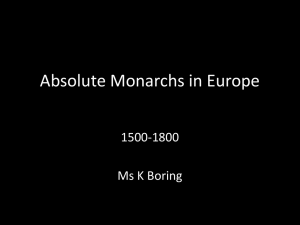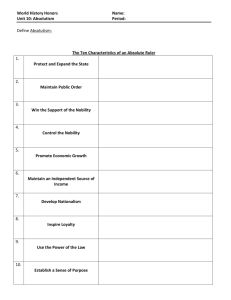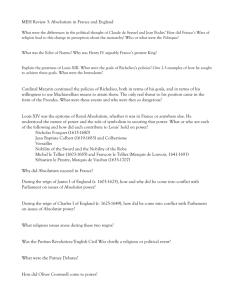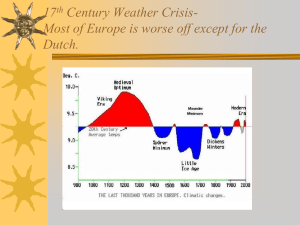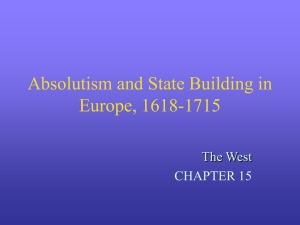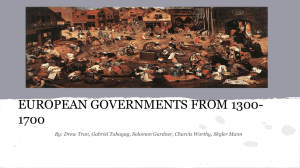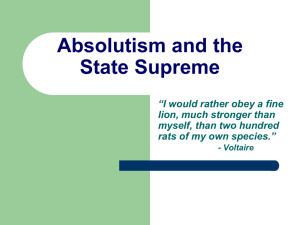Absolutism Was a Myth Socratic Seminar Materials
advertisement
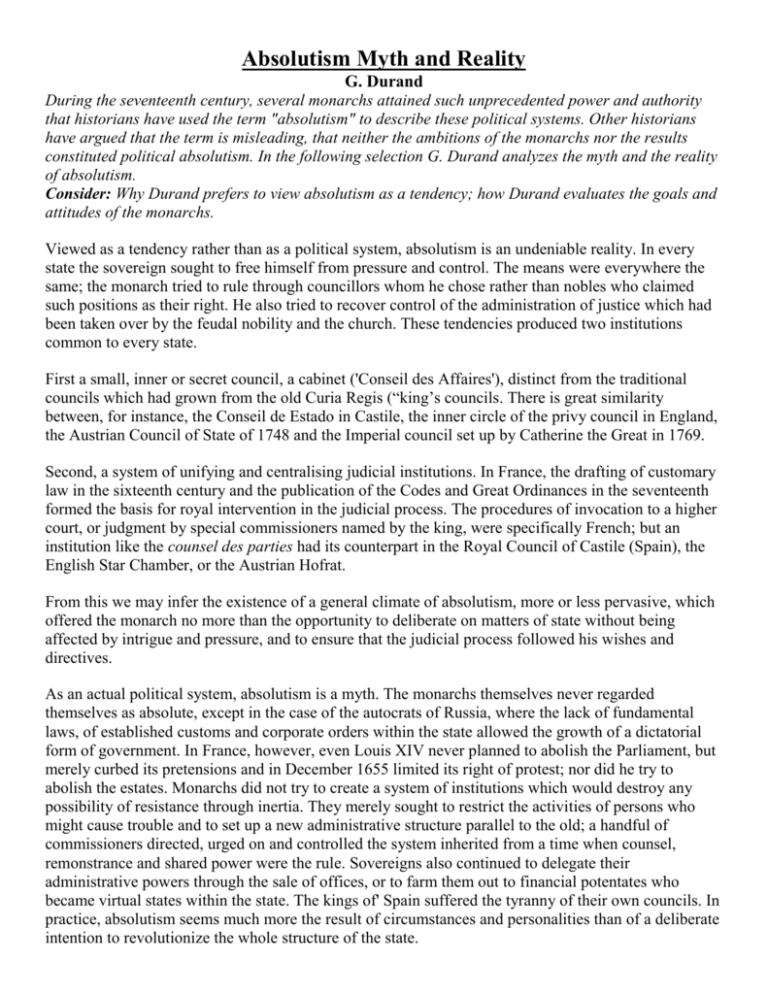
Absolutism Myth and Reality
G. Durand
During the seventeenth century, several monarchs attained such unprecedented power and authority
that historians have used the term "absolutism" to describe these political systems. Other historians
have argued that the term is misleading, that neither the ambitions of the monarchs nor the results
constituted political absolutism. In the following selection G. Durand analyzes the myth and the reality
of absolutism.
Consider: Why Durand prefers to view absolutism as a tendency; how Durand evaluates the goals and
attitudes of the monarchs.
Viewed as a tendency rather than as a political system, absolutism is an undeniable reality. In every
state the sovereign sought to free himself from pressure and control. The means were everywhere the
same; the monarch tried to rule through councillors whom he chose rather than nobles who claimed
such positions as their right. He also tried to recover control of the administration of justice which had
been taken over by the feudal nobility and the church. These tendencies produced two institutions
common to every state.
First a small, inner or secret council, a cabinet ('Conseil des Affaires'), distinct from the traditional
councils which had grown from the old Curia Regis (“king’s councils. There is great similarity
between, for instance, the Conseil de Estado in Castile, the inner circle of the privy council in England,
the Austrian Council of State of 1748 and the Imperial council set up by Catherine the Great in 1769.
Second, a system of unifying and centralising judicial institutions. In France, the drafting of customary
law in the sixteenth century and the publication of the Codes and Great Ordinances in the seventeenth
formed the basis for royal intervention in the judicial process. The procedures of invocation to a higher
court, or judgment by special commissioners named by the king, were specifically French; but an
institution like the counsel des parties had its counterpart in the Royal Council of Castile (Spain), the
English Star Chamber, or the Austrian Hofrat.
From this we may infer the existence of a general climate of absolutism, more or less pervasive, which
offered the monarch no more than the opportunity to deliberate on matters of state without being
affected by intrigue and pressure, and to ensure that the judicial process followed his wishes and
directives.
As an actual political system, absolutism is a myth. The monarchs themselves never regarded
themselves as absolute, except in the case of the autocrats of Russia, where the lack of fundamental
laws, of established customs and corporate orders within the state allowed the growth of a dictatorial
form of government. In France, however, even Louis XIV never planned to abolish the Parliament, but
merely curbed its pretensions and in December 1655 limited its right of protest; nor did he try to
abolish the estates. Monarchs did not try to create a system of institutions which would destroy any
possibility of resistance through inertia. They merely sought to restrict the activities of persons who
might cause trouble and to set up a new administrative structure parallel to the old; a handful of
commissioners directed, urged on and controlled the system inherited from a time when counsel,
remonstrance and shared power were the rule. Sovereigns also continued to delegate their
administrative powers through the sale of offices, or to farm them out to financial potentates who
became virtual states within the state. The kings of' Spain suffered the tyranny of their own councils. In
practice, absolutism seems much more the result of circumstances and personalities than of a deliberate
intention to revolutionize the whole structure of the state.
The Myth of Absolutism: Change and Continuity in Early Modern European History. By
Nicholas Henshall. Review by: A. Lloyd Moote The Sixteenth Century Journal, Vol. 25, No. 1 (Spring,
1994) [This is a book review- better than having you read the whole book!!]
Richard Bonney playfully entitled a review essay: "Absolutism: What's in a Name?" Five years later,
Nicholas Henshall, Head of History at Stockport Grammar School, has suggested a definitive answer"nothing." Drawing on a wide range of monographic works and general surveys, mainly on England
and France from the sixteenth to eighteenth century, Henshall assails the notion of "absolutism" as
being confusing for students, hopelessly inadequate for describing the practice of statecraft, and not
very convincing as a theory. In short, the author would have us abolish the term altogether and
concentrate on the give-and-take exercise of power by early- modern monarchs through royal
patronage and coopting of social elites.
The most obvious problem with Henshall's provocative solution is its premise. His introduction
sets up the straw person of an absolutism that never existed. In his model, absolutism-as practiced in
France and with the freedom-loving, limited English monarchy as a mirror image-was despotic
(antilibertarian), autocratic (no consultation), bureaucratic, and most of all "not English." However,
[the common conception was] absolutism in practice was not despotism. Furthermore, in theory
absolutism meant nothing more than that the monarchy was "absolved" or freed from legal restraints
by subjects and pope. Rather than abolish the term absolutism, … could we not take our cue [and]
understand the parts of that phenomenon even while admitting the whole to be an abstraction?
Henshall gives us some hope here, [and] does provide an interesting perspective on the
practice and theory of "absolutism." …He repeats chapter after chapter the general contention that
consensual elements were part of the fabric of all early modern states, and therefore that England
and France had much in common.
More to the point are Henshall's omissions. First, politics for Henshall is limited to the largely
collaborative interplay of government and elites, mainly nobility of sword and robe. …The vast
majority of subjects are virtually left out of his account, as rebels or integral members of the local
community. If we bring recent cultural-history discoveries about popular beliefs, rituals, litigation, and
so forth into the political picture, absolutism may look quite different from the top-down, patron-client
view of Henshall. And if we view the state as the product of community views, notably on family
matters, Henshall's deliberate dismissal of … social history-writing may look a trifle premature.
Finally, despite a general nod to chronology on French and English history, the author plays down
any sense of important political, social, or cultural change between the Renaissance and the French
Revolution. The grandees always seem to be retrogressive, selfish, "overmighty" subjects; the French
monarchy under Richelieu and as enlightened despotism changes only temporarily in flirting with
"despotism."This would appear to be a doubly troublesome generalization. It undermines the author's
dismissal of absolutism, which at this point in the argument appears to be very much alive, normal,
and well defined. And it makes problematic the beginning and end of absolutist practice. …The
French Revolution is reduced to the "mistake" by Louis XV and Louis XVI of not exercising "normal"
control over ministers, or the usual employment of patronage to make the elites feel they were part of
the political system. There is much to chew over and debate in this lively, contentious, and very selfconfident book.
The Facade of Legitimacy: Exchange of Power and
Authority in Early Modern Russia DONALD OSTROWSKI, Harvard University
Comparative Studies in Society and History, Vol. 44, No. 3 (Jul., 2002)
From the middle of the nineteenth century until recently, the only acceptable way to discuss
political developments in early modem Europe was in terms of the rise of absolutism. "Absolute
monarchy" was the political theory of early modem states formulated by ideologues of their respective
regimes. Later historians accepted this ideology as the way these monarchies operated and formulated a
model called "absolutism," which posits a monarch who accrues power at the expense of the nobility.
During the last three decades, however, a number of historians, whose studies focus on elite politics,
have undermined this historiographical model. Through their archival research on the operation of
regimes in early modem Europe, these historians have instead described an interlocking relationship
between ruler and nobility in which the ruler acted as legitimizer of the nobility and adjudicator of
differences among its members.' Then, in a strongly argued book, The Myth of Absolutism, Nicholas
Henshall delivered what many specialists consider to be the coup de grace to the absolutism model as a
worthwhile way of discussing early modern European governments.
Meanwhile, non-specialists still hold, write, and teach the construct as it was developed in the
nineteenth and twentieth centuries. Textbooks still espouse "absolutism" as part and parcel of the
centralization and nationalization of the state. And a number of specialists continue to use the term and
concept of absolutism while at the same time incorporating some and ignoring other objections of the
revisionists. What is the absolutism model and what is its appeal for explaining early modern European
domestic politics?
In the standard absolutism model, a visionary monarch, who is often allied with the bureaucracy
and/or military, acts in opposition to the childish and selfish (feudal) nobility in order to create a
national state, which in turn evolves into the modern nation-state. While the term "absolutism" began in
the early nineteenth century as a pejorative term, it soon gained a "progressive" sound in the hands of
historians as it began to be seen as a necessary phase in the transition away from "feudal"
decentralization.4I n the most recent (5th and 6th) editions of a popular Western Civilization
textbook,5 for example, the reign of Henry IV (1589-1610) is described as "progressive and promising"
(5th, p. 526; 6th, p. 534) for he "laid the foundations of later French absolutism" (5th, p. 525; not in
6th). Moreover, the nobility was "the greatest threat to monarchy" (5th, p. 524; 6th, p. 531), and the
French nobility in particular, "with its selfish and independent interests, had long constituted the
foremost threat to the centralizing goals of the Crown and to a strong national state" (5th, p. 526; 6th, p.
534). People like Richelieu, who "set in place the cornerstone of French absolutism" were trying "to
break [6th, "curb"] the power of the nobility" in or-der to accomplish those goals (5th, p. 526; 6th, p.
534). But the main difference on this matter between the 5th and 6th editions is the use of half a
column of textbook space to discuss the views of the "revisionist" James B. Collins, who has declared
his belief that "the prevailing historiographical concept of 'absolute monarchy' is a myth, promulgated
by the royal government and legitimized by historians."6 Nonetheless, the textbook continues to
present the absolutism construct as the preferable way for describing early modern mon-archies. In this
construct, the government of France is considered the exemplar of absolutism while the government of
Russia is an extreme variant, which historians often call "autocracy."
No doubt, the transition from specialists' research to textbook surveys and popular accounts
takes time, but there may be another reason for the prevailing dichotomy: the absence of a new model
to replace the old one. A monarch in opposition to his or her own nobility is an easy construct to learn
and remember. It has drama; and there is evidence of such conflicts occurring from time to time. As a
result, this old, unsatisfactory model (unsatisfactory from the point of view of correspondence with the
available evidence) continues to be espoused by teachers and scholars despite the muted objections of a
few specialists to deter them. In addition, some specialists still accept the term "absolutism" but with
different understandings of what that term means. While a number of historians have asserted that
centralization is the key component of the French absolutist monarchy, Richard Bonney has argued that
"[t]he term 'centralization' is best avoided by the historian of early modern France" for the term is a
later coinage and the concept was "alien to sixteenth-century and seventeenth-century political theory."
Further more," centralization" may be too grand a term for the process of formalization of lines of
administration, especially when one considers how little central control the monarchies were able to
exert during this period.
In short, at present we may be in the throes of a paradigm shift but without a new paradigm
crystallizing sufficiently for a fresh consensus to form around it. One group of historians holds to the
traditional ruler-vs.-nobility under-standing of absolutism. A second group still uses the term
"absolutism," but sees more cooperation than conflict between ruler and nobility. And a third group
rejects the term "absolutism" altogether as misleading and anachronistic. It may be time for an
assessment of where we are at the moment and try to determine where we are heading.
…..
Admittedly, there were conflicts between the ruler and ruling class, but they represented more a
breakdown, a design flaw in the system as it were, than how the system was supposed to operate.
Historians who see "absolutism" as a transition phase between feudalism and modern democratic
nation-states tend to focus on the conflicts as evidence of that particular type of transition occurring.
Likewise, there were times when a monarch acted despotically, but that too rep-resented an anomaly,
not the system itself. Or as Henshall wrote: "The concept 'absolutism' erects into an organized system
what was almost unanimously recognized before 1789 as a malfunction."'
Instead, a facade of legitimacy was created by members of the ruling class through declarations
of abject allegiance to, and ritual glorification of, the monarch in order to underwrite the coercive
power of the ruling class toward the rest of society. By "facade of legitimacy," I mean a front presented
to cover the various divisions, factions, compromises, and personality conflicts with-in the ruling order,
so that decisions seem to emanate from a single authority-the monarch. Implicit in this notion is a "selfpolicing" mechanism to ensure that all members of the ruling class were "on the same page" in regard
to sup-port for the regime and its actions." Reaffirmations of this allegiance through rituals of
submission were continually being made to create the impression that the ruling order's rule was
legitimate-that is, based on something more than brute force. In middle and late Muscovy, these
reaffirmations of allegiance were especially important because, outside the boyar rank and prelates,
there was little else in the nature of dress or behavior to distinguish members of the ruling class from
the rest of the population.
…
In France, during the same time, the monarchy also moved toward more in-formal means of
consensus building. The most prominent example is the non-calling of the Estates General after 1614
and the Council of Notables after 1627. At roughly the same time that Aleksei Mikhailovich was
increasing the size of the Boyar Council in Muscovy, Louis XIV was decreasing the size of the Council
of State in France. In France, however, formal institutional restraints existed that did not exist in
Russia, that is the provincial Estates and the parliaments. These for the most part cooperated with the
ruler, but on occasion, as during the Fronde and in the 1780s, they could and did resist the ruling
authority.
In contrast, in two other states, the Polish-Lithuanian Commonwealth (Rzeczpospolita) and
England, institutional and codified limitations increased during this period. In the Commonwealth, the
pre-existing idea of the elected monarchy (pacta coventa) was invoked in practice after the death of the
last Jagellionian king in 1572, with civil wars resulting on at least four occasions- 1576, 1587, 1697,
and 1733-and the power of the Sejm (representative assembly) was strengthened. In England, Charles I
did not call Parliament into session between 1629 and 1640, although he met with his Privy Council,
made up of members of the nobility, on almost a daily basis. Eventually, he had to acquiesce to
reconvening Parliament because the government needed money. During the course of that century,
English monarchs were chosen on three occasions (James I, Charles II, and William and Mary) and two
kings were de-posed, in one case (Charles I) through beheading and in the other case (James II)
through being asked to leave the country. Throughout these three centuries in all these polities what is
most striking is the functional continuity of the ruling class.
…
The old absolutism model views the aristocracy's power as decreasing as the monarch's power
increases, and vice versa, a zero-sum game between two op-posing sides. And it sees the monarch as
representing the broader interests of the state against the narrow interests of the nobility. Yet,
customary behavior was for the monarch and nobility to reach agreement over division of the spoils
and exploitation of the populace. In this way, the ruler and the ruling class were mutually reinforcing.
The members of the ruling class acquired power through their patronage networks and exchanged some
of that power for the authority of the ruler to maintain those networks intact. The ruler acted not only as
the keystone of the system but also as an adjudicator of differences among the members of the ruling
class. In other words, although individual members might lose their power, the aristocracy as a whole
gained power along with a strong monarch. This was Montesquieu's point about the flow of power
through the nobility within a true monarchy
…
A unified nobility that negotiated and reached agreement with an engaged monarch was to the
mutual benefit of both nobility and monarchy. Gustavus Adolphus II (1611-1632), generally regarded
as Sweden's greatest king, ruled effectively for twenty years after signing the Accession Charter of 31
December 1611, in which he agreed to seek the consent of the Council (Riksrdd) for making laws,
imposing taxes, levying troops, deciding foreign policy, and summoning the Riksddg. Gustavus
Adolphus also agreed to protect the rights of the Lutheran Church and to ensure that the most important
civil and military positions went to members of the Swedish nobility. Furthermore, Gustavus Adolphus
appointed Axel Oxenstierna, who was the main drafter of the Charter, as chancellor, and worked
closely with him throughout his reign. This arrangement was renewed in 1634 under Gustavus
Adolphus' daughter, Christina. Although Christina was a child at the time and Sweden was under a
regency of five officers of the state (each of them a nobleman), when she came of age she ruled
according to the 1634 formulation.39T o be sure, relations of the Council with Christina were less
harmonious than during her father's reign. Nonetheless, she did not miss many meetings of the Council:
of the seventy-three meetings of the Riksrad in 1652 and 1653, Christina attended sixty-three.40 Again
we see the ruler and the ruling class working together to the mutual benefit of both.
…
One of the standard interpretations of Catherine II portrays her as a hypocrite who paid lip
service to the ideals of the Enlightenment and then cynically ignored those same ideals. A prominent
historian called them "window dressing and propaganda."66 Another prominent historian summed up a
widely held assessment when he wrote: "in spite of Catherine's enormous display of enlightened views
and sentiments and of her adherence to the principles of the Age of Reason, it remains extremely
difficult to tell what the empress actually believed, or whether she believed anything." Such views can
apparently be supported by Catherine's claim in her Instruction to the Legislative Commission of 1767:
"The Sovereign is the autocrat; for there is no other power but that which centers in a single person,
that can act with a vigor proportionate to the extent to such a vast domain." If she was an "autocrat" in
her "power," t hen these historians have some justification to wonder why she did not implement the
reforms that she said she wanted to. Other historians have already provided an answer: the nobility,
with whom Catherine was in alliance, were not in agreement with her or with each other that such
measures were a good idea.9 Catherine did introduce gradual reforms, most notably in administration,
education, especially for women, and in granting the right of private property to members of the ruling
class.70 But when juxtaposed to the sweeping administrative changes Peter I had introduced, her
measures seem timid in comparison.
…
Those who question why Catherine did not push reforms forcefully against the nobility, as Peter
the Great was supposed to have done, can find their answer in the fact that Peter did not have
Catherine's political liabilities and, thus, had much more elbowroom for his activities. He was able to
pursue measures forcefully against particular individuals within the ruling class but only because he
maintained the support of the ruling class in general, most likely because there was no feasible
alternative at the time. Such a consideration helps to ex-plain his harsh treatment and ultimate
execution of his son Aleksei, who could have become a focus of opposition among disgruntled
members of the ruling class.
…
Rulers need a power base, and during this time that power base rested with-in the ruling class. In
societies of privilege, as most societies were before the French Revolution, this power base did not
reside within the civil service or bureaucracy. It is simply anachronistic to apply such a frame of
reference to societies that had not undergone the type of transformations that the French Revolution
wrought. And, indeed, it was precisely from the anti-aristocrat propaganda of the French Revolution
that his anti-aristocrat frame of reference emanated. The idea that the nobility in France, Germany, or
Russia was childish and selfish and petulantly blocking the far-seeing visionary that was the king is not
entirely supported by the evidence (although it made for a great movie, Sergei Eisenstein's Ivan the
Terrible).
To be sure, the civil service of western European countries was expanding rapidly in the
eighteenth century to the point where they became powerful enough in France to provide the means
and expertise to overthrow the monarchy. In early modern Russia, there was a record keeping apparatus
and it was rather well developed, but I would avoid calling it a "bureaucracy." It is misleading and
somewhat anachronistic to speak of "bureaucracy" in the denotative sense ("rule by bureaus")
anywhere in Europe before the French Revolution. It was only as a result of the introduction of
principles of professionalism and governance by standardized procedures in civil service ranks that
such an aspect of modernization as "bureaucracy" can be said to exist in the Western context.
Furthermore, it was still acceptable practice for members of the nobility to intervene to overturn
administrative decisions. The introduction of "bureaucracy" is quite different from the old ruling class
of monarch and nobles, and is sharply antagonistic to it.
In non-constitutional monarchies, the aristocracy along with the king or queen were the rulers of
the country. Like the samurai under the Tokugawa Shogunate, "their vocation was government," in the
words of the historian R. P. Dore, "and good government was largely a matter of correct dispositions
on the part of the governors." The administration of Russia, as it was in Japan, w as in the hands of the
aristocracy-that is, rule by the "best" (aristos, best + -kratia, rule). That was their job and they were
born to it. Why else, they might have said to themselves, would God have made them aristocrats if they
were not meant to rule? From their point of view, it is only the aristocracy that has the interests of the
common good at heart, and the ruler and the nobility together were the state.
The nobility would have found it crass to describe their activities as dividing up the spoils or
exploiting the serfs. For them, the serfs were something less than adult humans, perhaps more like
children’s o "parenting" them was in the natural order of things, and, in order to do this, control had to
be maintained over the various sosloviia of society. Such a view had its ironies since the nobility
seemed often to occupy the role of children at play while the serfs and peasants were in the role of
hard-working adults. Princess Dashkova herself eloquently defended the institution of serfdom to
Diderot:
At one time I held the same opinions as you, and thought of giving more freedom to my
peasants and making them happier. I changed the administration of my estate in the Orel
Province with this end in view, and yet I found they merely became more liable to be pilfered
and robbed by every little employee of the Crown. The welfare and wealth of our peasants
create our own prosperity and increase our revenues. A landowner would have to be crackedbrained to want to exhaust he source of his own riches. The gentry serve as intermediaries
between the peasants and the Crown, and it is in their interest to defend the peasants against the
rapacity of Provincial governors and officials.
Here, Dashkova is not alluding to "bureaucratic absolutism," a n alliance of monarch and
bureaucrat against the nobility, but to officials who were abusing their power and overstepping their
legal limits. Members of the aristocracy had their rationalizations for why they did what they did, and
they expected to be rewarded for their efforts in maintaining the natural order, which basically
consisted of keeping themselves in a position of dominance. "[E]ach will keep to his own station
(sostoianie)," in Shcherbatov's hopeful phrase, and not get above himself. The monarch was part of this
process, which explains why neither Catherine II nor any other Russian ruler before Alexander II
(1855-1881) did much to alleviate the lot of the serfs. The political and economic status of the ruling
order was dependent on serfdom, and the members of the ruling class were the monarch's
administrators of that institution. It was not a question of having the government limit the power of the
nobility, because the nobility, from their point of view, ran the government. And, as Princess Dashkova
pointed out, the nobility felt they had to intervene to limit the abuse of power by non-noble government
officials. Nonetheless, this arrangement between the ruler and the ruling class could result, as LeDonne
pointed out, in "permanent tension."' To ameliorate the tension and to deter the arbitrary exercise of
power by the monarch, t he principle of zakonnost' (literally, "lawfulness") was invoked. Zakonnost'
meant the rulers of Russia were obliged to limit their own power in accordance with precedent
established by the actions of their predecessors and of themselves. The ruling elite was there to ensure
that the ruler respected those limitations, at least toward themselves. Russian rulers, a t times, felt and
expressed frustration concerning this constraint.
…
Each ruling class developed its own ways of negotiation, consultation, and consensus. Once that
consensus was reached, the decision was enacted under a facade of legitimacy centered on the
monarch. The monarch backed by the ruling class had absolute power over the rest (the non-ruling
class part) of society, but when dealing with the ruling class itself the monarch violated the informal
limitations and formal restraints of power at his or her own peril. The system may not have been pretty,
but it worked in Russia and elsewhere at least until the civil servants and lawyers, first in France, then
in other countries, began to think they had a better way of doing things and, in the name of the state and
so-ciety, began to replace the old ruling order with themselves.

